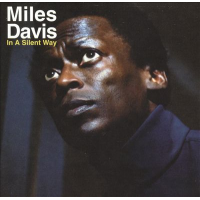Home » Jazz Articles » Reassessing » Miles Davis: Miles Davis: In a Silent Way
Miles Davis: Miles Davis: In a Silent Way
 Miles Davis
Miles DavisIn a Silent Way
Columbia
1969
Recording in February 1969, Miles Davis seemed to pick up the vibe of what was going to go down that crazy summer. It was a tumultuous time as the sixties came to a close. First came the Manson Family, then the murder during the Stones' Altamont show overshadowing the na've utopia of Woodstock. With In a Silent Way Davis seemed to sum up the dying of the light as the war and violence took over from love and peace. Certainly his most somber record since Kind of Blue , it was a reflective record that would bridge the gap from one of the greatest quintets in jazz history to the most controversial era of Miles Davis' work.
In a Silent Way is a foreboding and deeply meditative record that has an almost spiritual quality. Following on his first real plunge into jazz-rock fusion on Filles de Kilimanjaro , the quintet's last record, In a Silent Way was a real head twister. Following Filles' blues-rock-jazz ideology, Davis really pulled together the methods that he began with on the previous release. But the change was the low-lying, almost silent feel. Gone were the funky up-tempo tracks, replaced with two long tracks with sparse arrangements that relied more on atmosphere than any of Miles' earlier records.
Holding onto Tony Williams, Herbie Hancock and Wayne Shorter from the quintet, Miles added future fusion gods Chick Corea and John McLaughlin, as well as Dave Holland (filling Ron Carter's shoes on bass) and organist/pianist/composer Joe Zawinul. In a Silent Way tackles the tone palette of Kind of Blue , setting into an electric fusion. Opening with the subtle and quiet "Shhh/Peaceful," the record begins a soothing adventure, led by Zawinul's trippy drops of organ. Slowly the track picks up with Williams doing double time on the hi-hat throughout. But McLaughlin is the major soloist, and what would become his signature guitar chops softly intertwine throughout. Finally Miles and Wayne take the stage and fill the holes in with killer solos that rival some their best work from Miles Smiles and Nefertiti. But the B-side with "In a Silent Way/It's About that Time" opens with silence and Williams continuing where he left off—a continuing groove would be played to dreadful bore on On the Corner three years later. The track really shifts as the jam of "It's About that Time" takes off and builds into some classic Davis/Shorter playing that really lays out what is about to come on Bitches Brew. The tracks eases off again and goes back into "In a Silent Way."
Without hearing this overlooked gem, many fans of jazz have missed out on one of the genre's most original and all-encompassing works. The record has recently gotten the full treatment with Columbia/ Legacy's Complete Sessions box set and it continues to prove how vital it is to the Davis catalogue. The record is an essential piece to understanding Miles and where jazz was heading. Its mix of rock and fusion point to Remembering Jack Johnson (rock) and Bitches Brew (fusion). Two important notes are the emergence of Joe Zawinul and the editing and production of Teo Macero who would both be focal points in the movement of Miles' music. Zawinul's presence on organ gives the record its otherworldly feel, but the groove and layout of the record are credited much to Macero's time at the knobs. His splicing and rearranging would become instrumental in the emergence of Miles' sound especially on Bitches Brew and On the Corner. Building and peaking the long tracks so that their flow was consistent and maintained the ideology of the piece.
In a Silent Way is a one of kind record that mixed the late-'60s pop and underground movement into the jazz realm. On this record Miles began to hook into the late '60s sounds that flowed from the jam bands in San Francisco. No more is that more evident that in the otherworld-like organ of Zawinul. Starting with Filles the groove of Jimi Hendrix really started to take shape in the work that Miles began 1968. This is best shown on disc one of the Complete Sessions. The opener "Mademoiselle Mabry (Miss Mabry)" has its foundation based on Hendrix's "The Wind Cries Mary." Through Macero's production and Miles utilizing the same musicians would bare similar but ever-evolving grooves with each release. They would never make a record like it again, an absolutely timeless work that proves that Miles Davis and crew were some of the most innovative thinkers in modern music.
Suggested Spins:
Miles Davis -The Complete In a Silent Way Sessions Columbia/Legacy '01
Miles Davis -A Tribute to Jack Johnson Columbia '70
Miles Davis -Bitches Brew Columbia '70
Herbie Hancock -The Prisoner Blue Note '69
Herbie Hancock -Fat Albert Rotunda (Available on the exquisite Mwandishi: The Complete Warner Bros. Recordings 2cd set) Warner Brothers '69
Mahavishnu Orchestra With John McLaughlin -The Inner Mounting Flame Columbia '71
Comments
Tags
Miles Davis
Reassessing
Trevor MacLaren
United States
Tony Williams
Herbie Hancock
Wayne Shorter
Chick Corea
john mclaughlin
Dave Holland
Ron Carter
Joe Zawinul
Jimi Hendrix
For the Love of Jazz
 All About Jazz has been a pillar of jazz since 1995, championing it as an art form and, more importantly, supporting the musicians who create it. Our enduring commitment has made "AAJ" one of the most culturally important websites of its kind, read by hundreds of thousands of fans, musicians and industry figures every month.
All About Jazz has been a pillar of jazz since 1995, championing it as an art form and, more importantly, supporting the musicians who create it. Our enduring commitment has made "AAJ" one of the most culturally important websites of its kind, read by hundreds of thousands of fans, musicians and industry figures every month.



















